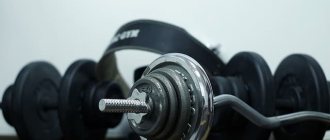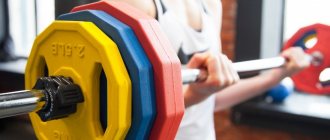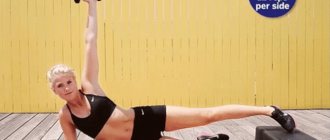What kind of exercise is this
Unlike other exercises on the horizontal bar, the rivet is a purely technical element. That is, even those athletes who have difficulty doing pull-ups or cannot perform a two-strength exit can do a pull-up on the horizontal bar. Perhaps the only requirement for a barbell lift is sufficient grip strength. Although this rule applies to any exercise of this kind.
In fact, the rivet bar exercise is an easier form of strength training for two, in which the main task is performed by inertia and technique, rather than pure physical strength.
Tabata Workout Example
We have prepared a suitable example of a Tabata training session especially for you. You can use it for your own purposes, subsequently changing the exercises as desired.
Exercise No. 1
— Burpee (20 seconds)
Rest
(10 Seconds)
Exercise No. 2
— Jump squats (20 seconds)
Rest
(10 Seconds)
Exercise #3
— Jumping lunges (20 seconds)
Rest
(10 Seconds)
Exercise #4
— Lying arm and leg raises (20 seconds)
Rest
(10 Seconds)
Exercise #5
— Jumping up, knees to chest (20 seconds)
Rest
(10 Seconds)
Exercise #6
— Push-ups with clap (20 seconds)
Rest
(10 Seconds)
Exercise No. 7
— Change of legs in a jump (wide-narrow) (20 seconds)
Rest
(10 Seconds)
Exercise #8
— Rivet on the floor (knees touch chest) (20 seconds)
Over time, you can use dumbbells to increase the load. The more intensely you perform all the assigned exercises, the greater the effect you will achieve.
A fairly popular element to perform on the horizontal bar is the so-called kipping or kip-up, which allows you to effectively work large muscle groups, develop body coordination and master more labor-intensive elements in the future.
For the rivet, the most important are the developed shoulders and the muscle group that is located in the lower back (this does not mean the buttocks, but the lower back). Thanks to these muscles, the main effort is performed; therefore, in order to perform a high-quality kip-up or begin to master this element, it is advisable to warm up and more thoroughly warm up these muscles, and, if necessary, select a group of exercises for their development and strengthening. However, this element is more technical and overly developed muscles are not required for high-quality riveting.
Mastering an element such as a kip-up can take a significant amount of time. In particular, in order to go straight to straight rather than bent arms (more on the actual execution of the rivet later), you will need to perform a significant number of repetitions. Due to this fact, it is advisable to use straps, especially if your wrists do not have a steel grip.
Performing a kip-up
The beginning of the exercise is gradual swinging on the horizontal bar, and the next phase is raising the legs to the horizontal bar.
Moreover, the most important factors that you should pay attention to when mastering the exercise are raising straight legs (here you will need a fairly elastic back, the back surface of the legs developed in terms of stretching), lifting the legs in a timely manner. In order for the body to further move along the desired trajectory, you need to raise your legs completely and straightened, and do this when the phase of pumping your body back is just beginning, that is, it is swinging forward, you feel when you start the reverse movement and raise your legs. The next phase completes the execution and involves coordinated movement of the pelvis and shoulder girdle. By inertia, the body with raised legs will continue to move, but in order not to just hang in the fold, but to go into emphasis on your hands, you need to move your pelvis closer to the bar when you start moving backwards and then add force with your shoulders. Ideally, the exit is performed immediately with straight arms and after a certain number of repetitions, you will easily understand how this is done.
Hi all. This article will talk about exercises on the horizontal bar in general, and specifically about how to make a rivet on the horizontal bar, and how to make a chair on the horizontal bar. If you don’t know what you can do on the horizontal bar, then read a little of this blog and you will learn a lot.
On the horizontal bar you can perform various interesting exercises that will surprise both you and the audience. Of course, the most important exercise on the horizontal bar is ordinary pull-ups. Having a good base in the form of pull-ups, you can learn to perform various gymnastic, strength and elements on the horizontal bar. What does "good base" mean? By "good base" I mean 20-25 clean pull-ups. If you pull yourself up this number of times, then you can start studying the elements.
I want to offer you articles that tell and show what can be done on the horizontal bar. I think you will like them.
What you can't do on the horizontal bar. This is, one might say, a unique and universal projectile. With its help, you can gain strength and pump up if you train correctly. You can perform various tricks and exercises that will surprise people. The Workout movement has spread quite widely, and in general people are aware of what can be done on the horizontal bar. Well, now let's look at a few exercises as examples.
Riveting
High chair
Benefits and disadvantages of exercise
The main advantages of the gymnastic vault:
- Strengthening muscles, increasing fitness to perform complex elements.
- Possibility to replace the power output with two.
- One of the first spectacular gymnastic tricks that can be mastered in a short time.
- Strengthening hands and grip strength.
- Strengthens the muscles of the core, back and shoulders.
There are no particular disadvantages to riveting on the crossbar. This is a basic element that almost everyone who does street workout masters. The only drawback is attempts to perform the exercise using brute force. As a rule, this ends in failure, since only technique plays a key role in mastering.
Lead-up exercises
In order to confidently perform a rivet on the horizontal bar, it is necessary to provide a reliable “background” in the form of physical training. Then mastering the element will be achieved quickly. Without lifting exercises, lifting will take much longer, in which case the process can take months.
Main supply elements:
- Swinging on the horizontal bar is a simple movement that involves the ability to swing the body. It is mainly necessary to strengthen the grip and shoulders.
- Horizontal pull-ups on a horizontal bar (an alternative is rows on TRX loops).
- Hanging leg raises to the bar.
These are the three basic movements that are necessary to learn how to do a pull-up on a horizontal bar. Also good for strengthening your shoulders (and especially your hands) are push-ups on your fists or fingers, pull-ups in any variation, as well as all exercises for the abdominal muscles.
Exercises
To pump up six-pack abs for a man in the shortest possible time, you need to use additional weights.
In this case, a sufficient load is organized, leading to micro-tears of muscle tissue and their subsequent restoration. P
In this case, the endocrine system uses hormones to adapt the body to increasing stress, which also helps to increase muscle tissue.
Execution technique
Classic technique of performing a kip-up on a bar (with a deflection):
- Grab the horizontal bar with a shoulder-width grip and begin swinging to create momentum.
- When you reach the maximum forward movement of your body, make a sharp bend and bring your legs to the horizontal bar.
- Swing your legs powerfully up and forward to create momentum. This will help “push out” the body and throw the body above the horizontal bar.
- Straighten your elbows and fix the position above the bar.
In this version, the position of the legs does not play a special role after passing the dead point, therefore, in order to prevent the lower part of the body from “pulling” in the opposite direction, it is recommended to bend the legs at the knees.
Training in "rivet" or kip-up
The rivet or kip-up is a strength element. It is performed as follows: on the horizontal bar with a slight swing at the moment when you fly forward, swing your legs and at the same time swing your shoulders and push your legs to carry yourself to the crossbar. To perform the rivet, be patient, break the exercise into several parts and practice them separately. We recommend starting to perform the parts in the sequence in which the rivet itself is performed. And so the conditional parts of the rivet:
- Shoulder swing . It should be performed from a place without swinging, only the deltoid muscles should work, the arm should not bend and it is recommended to perform it with an overhand grip so that the elbows look to the sides and when you come to a point-blank position you can spread your arms to the sides. You need to try to carry yourself as high as possible; it’s very good if you can look over the crossbar while doing this stage.
- How and when to cross your legs. You need to throw your legs at the very last moment - when the body goes back then you raise your legs, i.e. when your feet are at the crossbar, you should already be on the other side. The swing of the legs should be done in order to give greater force to the backward movement, which will make it easier for you to further reach the bar. Please note that when swinging your legs, you must bring your feet to the bar.
- Next we combine the first two stages . Namely, when you bring your feet to the crossbar, you are thrown back by inertia, just like in the first stage, you wait until you reach the peak point and then help yourself with your shoulders. The important point here is to keep your feet up. It is advisable that when performing this, your arms should become parallel to the ground.
- Push your legs up and away from you. This is done so that at the moment of the push you pull your pelvis to the crossbar and if at the same time you perform the correct movement of your shoulders, you will simply stretch out like a string parallel to the ground and then everything will go very simply, you will outweigh yourself, thereby reaching the upper stop. The push must be strong so that your pelvis does not even hit the bar very hard.
- Swing your legs from a standing position . It must be performed in order to better understand the mechanics of the element itself.
Gymnastic version of the rivet
There is an alternative technique for performing kip-ups called gymnastics. It has more stringent technical conditions and is considered more complex than the usual version. However, it is this version that allows you to make the element as clean as possible.
Technique:
- Start swinging your body on the horizontal bar.
- At the moment of peak forward movement of the body, raise your legs and bring them to the horizontal bar without bending the knee. This will require a greater angle of hip flexion and a slight increase in rounding in the lower back.
- When your legs reach the crossbar, make a sharp swing forward, pull yourself up with your arms in the other direction and, by inertia, reach a position above the horizontal bar.
How to learn how to rivet
If the exercise does not work the first time, it is recommended to work on each stage of the lift separately:
Swinging or swinging. When moving forward, you need to bring your legs forward as much as possible, and when moving back, raise your shoulders, keeping your arms straight. When swinging, your shoulders should be relaxed.
Raising your legs. Try, while hanging on the bar, raising your legs up. This exercise strengthens the muscles of the back, abs and will strengthen the hands.
Pushing off with legs. When you have mastered lifting your legs, you should practice simultaneously swinging and pushing your legs forward, trying to bring your pelvis to the horizontal bar and moving your shoulders up.
All elements can be seen more clearly in the video tutorial:
Basic mistakes
In most cases, if you are unable to perform a pull-up on the horizontal bar correctly, the reason is not weak muscles or level of training, but technical errors. Eliminating them will allow you to make significant progress in progression and quickly master the exercise.
Main mistakes in kipping:
- To create maximum inertia and correct body position at the peak point, try to pull towards the bar with your toes. This will help create more ejection force.
- Don't put your feet up too early. This will only lead to the fact that you will be “thrown back” and without the necessary inertial force you will not even come close to the dead center.
- Throughout the entire movement, the arms should be fully straightened. Elbow bending occurs only after you push yourself out of the leg swing and go above the bar.
- Provide good rocking in the initial phase. This is the key to successful completion of the element. Often athletes are afraid to swing enough, which is considered a significant mistake.
- Try to bring your pelvis as close to the horizontal bar as possible when performing the swing. Otherwise, it will “pull” you down, which is a mistake.
How to learn to make a rivet on a horizontal bar
A popular element on the horizontal bar, performed largely through technique, is the kipping lift, also called the rivet. It is performed by swinging, swinging the legs and shoulders to fixate on straight arms over the bar. Despite the apparent simplicity of the element, most will need time to master the technique.
Before performing the exercise, do not forget about warming up - a prerequisite before any workout. Before riveting, you especially need to warm up your shoulder joints, lower back and hands.
Recommendations for implementation in training
In most cases, it makes sense to actively train in performing an exercise only at the stage of mastering it. After this, the lift becomes a common element for entering the horizontal bar. During the mastery phase, you can do the movement an unlimited number of times, but although taking into account the load on the shoulder joints, it is better to distribute the training into short sessions (for example, 10 attempts followed by a break).
Basic recommendations:
- In this exercise, only technique and result are important. It is by these two factors that progress is tracked, so pay attention to correct execution even at the stage of mastering the lift.
- You should start moving only after a thorough warm-up. It is also recommended to perform several pull-ups, hangs and other movements to warm up the muscles of the shoulder girdle.
- If the correct execution of an element fails due to excess body weight, it makes sense to temporarily pay attention to burning fat. This will increase your body weight to strength ratio.
Read more about fat burning workouts for men →










